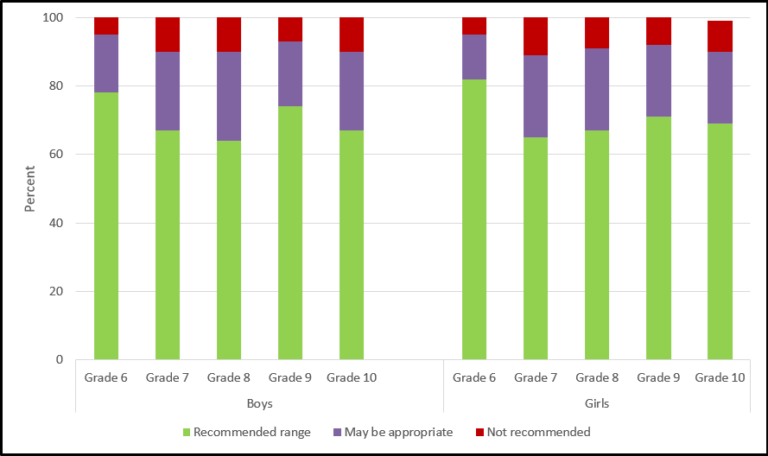4.2.3 Percentage of Canadian students in Grades 6 through 10 who had sleep duration that was within the recommended range of national guidelines, may be appropriate or was not recommended, by gender and grade, Canada, 2014

Source: CICH graphic created using data adapted from Health Behaviour in School-aged Children in Canada: Focus on Relationships. 2015.
We compared sleep duration to the National Sleep Foundation Recommendations for 6 to 13 year olds and 14 to 17 year olds.
When compared to the National Sleep Foundation Recommendations1 for children and youth among Canadian students in Grades 6 through 10, the average reported nightly sleep duration fell within the recommended range for 64%-78% of boys and 65%-82% of girls.
A further 17%-26% of boys and 13%-24% of girls had sleep durations that might be appropriate.
1National Sleep Foundation website. Accessed April 6, 2018. https://sleepfoundation.org/press-release/national-sleep-foundation-recommends-new-sleep-times/page/0/1
Implications
Problems going to bed and getting adequate sleep can be associated with a number of factors. Dealing with homework; extra-curricular activities; being online or on computers or mobile devices or busy schedules can all interfere with sleep time. Bedtime problems can start at this age for a variety of reasons. Homework, time with friends, sports and after-school activities, computers, TVs, mobile devices, and hectic family schedules all can contribute to kids not getting the sleep they need. Teenagers experience change in sleep patterns – physiologically their bodies are inclined to stay up later and wake up later. They may try to catch up on sleep on the weekend. However, this can also make it harder to fall asleep during the week.1
1Kidshealth. https://kidshealth.org/en/parents/sleep.html – accessed July 9, 2018.
